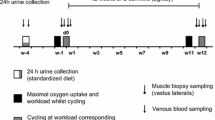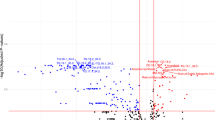Abstract
The goals of this study were to determine: (i) whether mammals mobilize particular nonesterified fatty acids (NEFA) preferentially during locomotion, (ii) if differences in aerobic capacity or diet can affect the pattern of NEFA mobilization and (iii) which individual NEFA are most representative of total NEFA concentration changes, to use them as tracers for turnover studies. Individual NEFA were measured in trained dogs and goats (VO2max dog/VO2max goat=2.2; where VO2max=max-imal oxygen consumption) during treadmill exercise at 40 and 60% VO2max. Important interspecies differences in individual NEFA concentrations could be attributed to differences in aerobic capacity. The more aerobic species (dog) had much higher plasma NEFA concentrations for all but one NEFA (18∶0), when compared with the low-aerobic species (goat). In addition, exercise caused a large increase in concentration of individual NEFA in the dogs, with the largest increases seen in 18∶1 (150% above resting values) and 16∶0 (60% increase), but it had no effect in goats. Therefore, the aerobic species has a much higher ability for mobilizing and transporting NEFA in plasma than its low-aerobic counterpart. Two NEFA accounted for more than half total plasma NEFA in both species, 18∶1 (about 35% total NEFA) and 16∶0 (20%). Calculation of variability in percent composition reveals that oleate and palmitate also closely reflect changes in total NEFA and are therefore the most appropriate tracers forin vivo kinetic studies in exercising mammals. Differences in diet and digestion physiology explained some differences in the plasma NEFA composition of the two species; this was reflected in the percent contributions of individual fatty acids to total NEFA: in dogs 18∶1>16∶0>18∶2>18∶0, while in goats 18∶1>16∶0>18∶0>18∶2. Also, only goats had 18∶3 (6% total NEFA), a fatty acid of plant origin, while only dogs had 16∶1 (7% total NEFA). Overall, however, the plasma NEFA composition of goats did not exactly reflect that of their diet due to preabsorptive modification of unsaturated fatty acids, while in dogs there was a good correlation between dietary and plasma NEFA.
Similar content being viewed by others
Abbreviations
- ANOVA:
-
analysis of variance
- CV:
-
coefficient of variation
- GC:
-
gas chromatography
- NEFA:
-
nonesterified fatty acid
- VO2 :
-
rate of oxygen consumption
- VO2max:
-
maximal rate of oxygen consumption or aerobic capacity
References
Newsholme, E.A. (1988) inPrinciples of Exercise Biochemistry (Poortmans, J.R., ed.) pp. 40–77, Karger, Basel.
Hochachka, P.W., and Somero, G.N. (1984)Biochemical Adaptation, pp. 85–144, Princeton University Press, Princeton.
Roberts, T.J., Weber, J-M., and Taylor, C.R. (1990)The Physiologist 33, A110.
McClelland, G., Zwingelstein, G., Taylor, C.R., and Weber, J.-M. (1994)Am. J. Physiol. 266, R1280-R1286.
Weber, J.-M., Roberts, T.J., and Taylor, C.R. (1993)Am. J. Physiol. 264, R797-R803.
Wolfe, R.R., Klein, S., Carraro, F., and Weber, J.-M. (1990)Am. J. Physiol. 258, E382-E389.
Nakamura, H., Faludi, G., and Spitzer, J.J. (1967)Diabetes 16, 175–180.
Taylor, C.R., Karas, R.H., Weibel, E.R., and Hoppeler, H. (1987)Resp. Physiol. 69, 1–27.
Dziuk, H.E. (1984) inDukes' Physiology of Domestic Animals (Swenson, M.J., ed.) pp. 320–339, Cornell University Press, Ithaca.
Argenzio, R.A. (1984) inDukes' Physiology of Domestic Animals (Swenson, M.J., ed.) pp. 301–310, Cornell University Press, Ithaca.
Jéquier, E. (1992) inEnergy Metabolism: Tissue Determinants and Cellular Corollaries (Kinney, J.M., and Tucker, H.N., eds.) pp. 123–139, Raven Press, New York.
Spitzer, J.J. (1975)Fed. Proc. 34, 2242–2245.
Hagenfeldt, L. (1975)Fed. Proc. 34, 2236–2240.
Fredrickson, D.S., and Gordon, R.S. (1958)J. Clin. Invest. 37, 1507–1515.
Paul, P., and Issekutz, J.B. (1967)J. Appl. Physiol. 22, 615–622.
Fedak, M.A., Rome, L., and Seeherman, H.J. (1981)J. Appl. Physiol., 51, 772–776.
Bahr, R., Hostmark, A.T., Newsholme, E.A., Gronnerod, O., and Sejersted, O.M. (1991)Acta Physiol. Scand. 143, 105–115.
Tserng, K.-Y., Kliegman, R.M., Miettinen, E.-L., and Kalham, S.C. (1981)J. Lipid Res. 22, 852–858.
Zar, J.H. (1984)Biostatistical Analysis, 2nd edn., p. 32, Prentice-Hall, Englewood Cliffs.
Havel, R.J., Carlson, L.A., Ekeland, L.G., and Holmgren, A. (1964)J. Appl. Physiol. 19, 613–618.
Hagenfeldt, L., Wahren, J., Pernow, B., and Ekestrom, S. (1972)J. Clin. Invest. 51, 3061–3071.
Carlson, M.G., Snead, W.L., Hill, J.O., Nurjhan, N., and Campbell, P.J. (1991)Am. J. Physiol., 261, E815-E820.
Lin, K.-C., Cross, H.R., and Smith, S.B. (1992)Lipids 27, 111–116.
Payne, E., and Masters, C.J. (1971)Int. J. Biochem. 2, 623–643.
Leat, W.M.F., and Baker, J. (1970)Comp. Biochem. Physiol. 36, 153–161.
Goodwin, T.W., and Mercer, E.I. (1983)Introduction to Plant Biochemistry, 2nd edn., p. 275, Pergamon Press Ltd., New York.
Wolfe, R.R. (1984)Tracers in Metabolic Research. Radioisotope and Stable Isotope/Mass Spectrometry Methods, p. 287, Alan R. Liss, New York.
Author information
Authors and Affiliations
About this article
Cite this article
McClelland, G., Zwingelstein, G., Taylor, C.R. et al. Effect of exercise on the plasma nonesterified fatty acid composition of dogs and goats: Species with different aerobic capacities and diets. Lipids 30, 147–153 (1995). https://doi.org/10.1007/BF02538268
Received:
Revised:
Accepted:
Issue Date:
DOI: https://doi.org/10.1007/BF02538268




